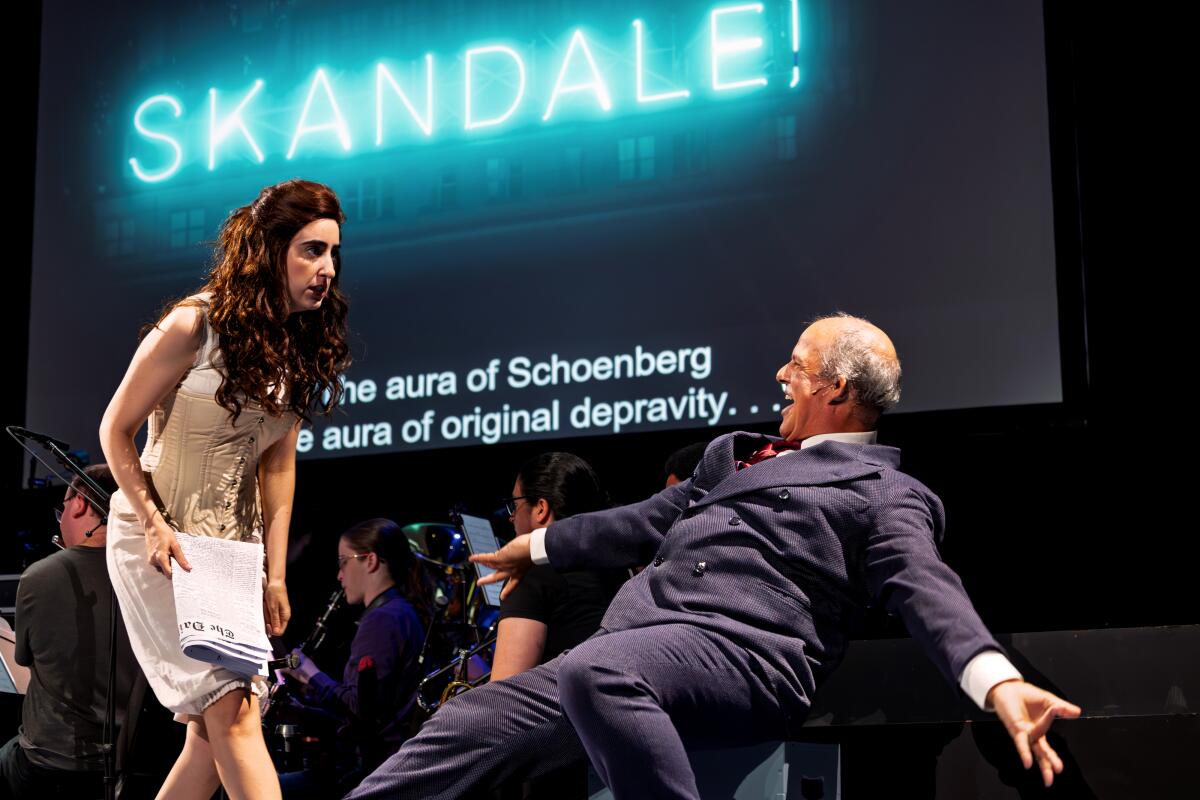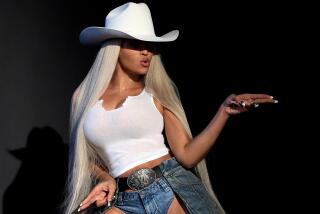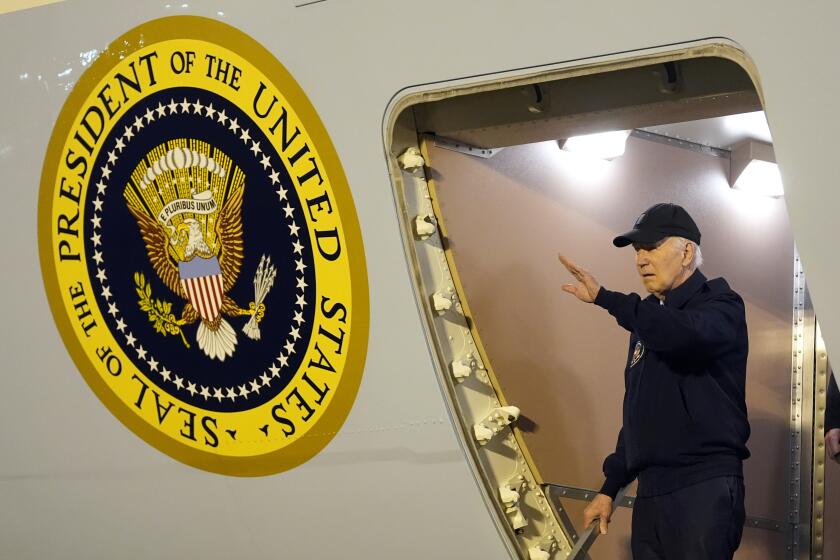To capture the outlandish subject of Schoenberg in Hollywood, it takes an opera

- Share via
There is a small and intriguingly personal sub-genre of operas about composers. Something is always up when one composer deals with another composer’s life and music.
Subjects have included Carlo Gesualdo, the 16th century madrigalist who murdered his wife and her lover. César Franck and others got a kick out of Alessandro Stradella, the Baroque opera composer who attempted to embezzle the Roman Catholic Church. Rimsky-Korsakov turned to Mozart and Salieri.
In the fall, Los Angeles Opera will premiere Sarah Kirkland Snider’s “Hildegard,” about the Medieval mystic Hildegard of Bingen. In the meantime, UCLA presented the West Coast premiere Sunday of Tod Machover’s “Schoenberg in Hollywood” at the Nimoy Theater, with performances through Thursday.

Machover, who directs the Opera of the Future group at MIT’s Media Lab, says he was drawn to the idea after he learned about the remarkable 1935 meeting of Schoenberg and MGM producer Irving Thalberg about scoring “The Good Earth.” The uncompromising German inventor of the 12-tone system had just fled Nazi Germany, and the meeting became a battle of high art and entertainment.
Schoenberg and the movies ultimately went in their independent directions, but the composer did become deeply integrated in L.A. culture, living across the street in Brentwood from Shirley Temple, teaching at USC and UCLA, playing tennis with George Gershwin (whom he adored), feuding with neighbor Thomas Mann (who opposed Schoenberg’s innovations) and hanging out with the Marx Brothers and Charlie Chaplin.
Machover’s opera begins and ends with Thalberg as a framing devise. The 90-minute opera is basically a phantasmagoria of how Schoenberg got here.
The superb libretto by Simon Robson (based on a scenario by Braham Murray) is a clever series of short flashbacks of Schoenberg’s life, with film accompaniment. Some are realistic, some fanciful. The three characters are Schoenberg, Boy and Girl. Boy and Girl represent all the characters in Schoenberg’s life with many a virtuosic costume change. We witness Schoenberg, who was born 150 years ago, starting out as a cellist and self-taught progressive composer in his native Vienna and Berlin. He flees the Nazis and, via Paris, Boston and New York, finally settles in Los Angeles in 1934, where he remains for the rest of his life.
Moving scenes reveal his personal life and its connections with his music, but as he reaches the New World wacky ones begin to creep in. He becomes Groucho and SuperJew. The films, which are cued as though musical elements, run the gamut of cinematic styles and periods. They include historic documentary scenes, modern enactments, cartoons and graphics.
Machover’s score for 15 instruments is its own complex delirium. An impossible composer to pin down, Machover has written a traditional grand opera such as “Resurrection,” based on Tolstoy’s novel, and “Brain Opera,” which is just that, using electrodes on your noggin. A trained cellist, he’s comfortable with acoustic instruments but also can’t wait to get his hands on whatever crazy invention the Media Lab’s irrepressible tech visionaries come up with next.
Musically and dramatically, “Schoenberg in Hollywood” has Schoenbergian denseness along with new-world electronics. Machover is particularly effective in evoking both the trauma and the exhilaration in Schoenberg’s spiritual progress as he reinvents himself after horrors of World War I, in which he fought, and again when confronted with new horrors of World War II.
The commanding performance by the UCLA Herb Alpert School of Music ensemble, conducted by Neal Stulberg, makes the high/low dichotomy irrelevant, leading us to a profound middle ground. Choreographer Karole Armitage, who bases the Nimoy production on the original one she created for Boston Lyric, operates, however, on extremes. Schoenberg comes across as either self-knowing prophet or goofball. Whimsy and wit become silly. Marx Brothers, Wild West and SuperJew stagings are saved only by the music.
The Hear Now Music Festival on Sunday and Tod Machover’s opera ‘Schoenberg in Hollywood’ raise the question of whether there’s ever been an L.A. school of music. Our critic has thoughts.
Omar Ebrahim’s imposing and magnificently sung Schoenberg is well-suited for visionary gravitas, less so for slapstick. Anna Davidson and Jon Lee Keenan, as Girl and Boy, turn on a dime. They move with dancers’ ease, allowing Armitage to create a sense of flow in the episodic opera. They can do silly, but also a lot more. Davidson was particularly gripping as Schoenberg’s first wife, Mathilde.
In some ways, Armitage seemed to be compensating for the small, bare Nimoy stage. Schoenberg no doubt attended movies in what is now the Nimoy, which was a movie theater until its recent renovation as a performing space for UCLA. It is an intimate space, which meant that Armitage had to do without decor, and which may have led her to overemphasize theatrics.
Amplification added a complication. The sound stage was too loud for vocal subtleties and too flat for careful instrumental and electronic music balance.
Still, Schoenberg would not be Schoenberg without obstacles to have triumphantly overcome. He changed music in Vienna and Berlin. He thrived in L.A. as composer, teacher and inspiration, fitting in as he needed to. He remained true to his (12-tone) school but also, when it pleased him, went rogue. Schoenberg even wrote a terrific MGM-style Hollywood Bowl fanfare that for no good reason never gets played.
Could “Schoenberg in Hollywood” be a wake-up call? Shockingly, Schoenberg remains starless on the Hollywood Walk of Fame.
More to Read
The biggest entertainment stories
Get our big stories about Hollywood, film, television, music, arts, culture and more right in your inbox as soon as they publish.
You may occasionally receive promotional content from the Los Angeles Times.












